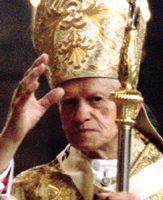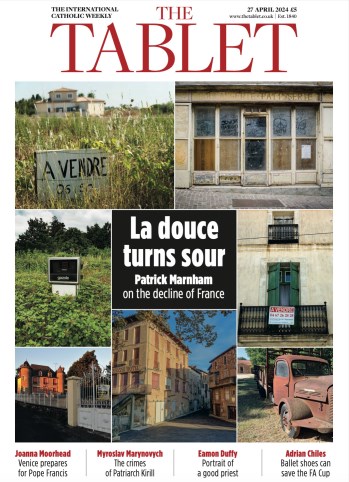There has long been an ambivalence about the man who was both the ultimate betrayer and the means by which God’s plan was fulfilled. The author of a new book visits the lonely place where the renegade apostle took his own life
The short, stout, balaclava-wearing Greek Orthodox nun peers out round the half-opened red metal front gate of St Onouphrius’ Monastery. “You’re very lucky,” she pronounces.
Since the 1890s the monastery has been the only lived-in structure on Hakeldama, originally the Aramaic hagel dema, sometimes rendered as the Greek Akeldama, meaning “Field of Blood”, and the spot below the Old City of Jerusalem where Christian tradition holds that Judas Iscariot ignominiously committed suicide after betraying Jesus.
The monastery is a small, fortress-like compound, clinging to the rock face and surrounded by high walls. These are topped by barbed wire, above which peep the branches of trees. Perhaps a Judas tree, the pink-flowering Cercis siliquastrum, which got its name because, reputedly, its branches once played host to Judas’ rope?
“We’re closed,” says the nun, with a short-sighted smile, “but I’ll let you in.” The notice board outside specifies the monastery’s brief weekly opening hours, including this particular morning and this precise time, but it feels rude to point it out as she hospitably swings the door open.
We step into a wide, glazed porch area, with large picture windows looking out northwards towards the Old City, and the white, marbled steps made up of gravestones in the Jewish cemetery as they climb up the slopes of the Mount of Olives. Around us are a couple of dusty plastic tables with cellophane-wrapped floral covers, which might once have belonged in a cafe, long since abandoned. In one corner stands a small, crudely constructed piety stall with sachets of dried herbs for sale, plus booklets and prayer cards about St Onouphrius, a fourth-century hermit monk believed to be buried here. But, curiously, not so much as a passing reference to Judas.
There are, the nun reveals guilelessly, only two sisters living in the monastery now (a third died recently) and – here she gestures to the walled garden behind her, visible through an open gate – it is all getting too much for her. A pile of pruned olive tree branches and ripped-up geranium stalks lies by the entrance, waiting to be removed.
I’m starting to wonder if I’ve come to the wrong place, and eventually find a gap in her monologue to slip in the name of Judas. There is an immediate pause, and then the nun sighs impatiently. “You are welcome to look round,” she says, suddenly weary, “but the garden is private.” She turns to retreat into it.
“Is there a particular place in the monastery where Judas’ death is marked?” My question is addressed to her back. I’m choosing my words as neutrally as I can, but a part of me is hoping that she will point to a tree.
The nun shakes her head. “Our chapel is through there.” She points to an arch at the other end of the porch and then she really does disappear through the garden gate, closing it firmly behind her. I am left all alone in this peculiar place, where visitors apparently no longer come, and Judas is he-who-must-not-be-named.
I had not exactly been expecting an all-singing, all-dancing celebration of Judas’ life – the sort of dramatic re-enactment pumped out by an overhead projector onto a video screen that has become de rigueur in historic houses nowadays. But it had seemed reasonable, in planning this visit, and given the long – though admittedly thinning – trail of pilgrims’ accounts of coming to the spot, to hope for some sort of discreet memorial: a plaque, perhaps, to mark the supposed place of Judas’ death, with solemn words and an unspoken warning not to follow in the traitor’s footsteps; or else a prayer card on offer, or an invitation to light a candle, as an opening to a deeper reflection upon his story, and the still unresolved questions it poses.
Whether, for example, to abhor Judas, in line with the Church’s traditional and lurid blanket condemnation of him as Satan’s tool, or to be swayed by the gentle recasting of his role as God’s agent that has gone on in recent times. Out-and-out traitor or cog-in-the-wheel of a divine plan? That was the headline-making question reportedly posed in 2006 by Cardinal Walter Brandmüller, then the head of the Pontifical Committee for Historical Sciences.
Plain and white on the outside, save for the trademark onion dome of Greek Orthodox churches, the monastery’s chapel is small, cluttered and low-ceilinged, with stalactites of hanging lamps dividing up the inside space that is mostly burrowed out of the rock face behind. Its primary purpose, it quickly becomes apparent when I manage in the gloaming to locate the light switch, is to honour the obscure St Onouphrius.
Back in Jerusalem, layers of story, from whichever faith group was then controlling the city, are superseded by new layers, put down by new rulers, from a different faith tradition, once they wrest control. And on and on as the city has passed back and forth through the hands of Jews, Christians and Muslims to this day. Yet, probably because of all the competing claims to the ownership of the places that exist, now and apparently always, this is also a city where the surface layer of history is notoriously thin, allowing previous authorised versions to leak through.
Here at Hakeldama, the current top layer is a historically tenuous connection with a fourth-century hermit. Very little is known about Onouphrius, and even within these crumbs there is no real link to Jerusalem. No wonder so few people come to visit. So why has it happened? Why has the cult of an obscure saint been written so large as to all but obliterate the shadow that Judas’ corpse, hanging on the end of a rope, casts over his “bloody acre”?
I’m still puzzling over that one when a previous layer peeps through. As I search in the darkened corners of the chapel, I come across a single, dusty icon, dated 1912, hidden behind an Ovaltine-coloured marble plinth. It makes a crude but revealing attempt to weave Onouphrius into Judas’ traitorous tale. The richly decorated panel, in greens, reds and blues against a gold background, features most obviously the risen Christ in the centre, the blood still flowing crimson from the wounds made by the crown of thorns on his head. Around this dominant figure, though, is arranged a series of small vignettes, telling in chronological order those three best-known gospel episodes in Judas’ journey to this place. Plus an extra two.
It kicks off in the top left corner with Judas being rewarded for betraying Jesus to them by the Jewish chief priests with a swag bag, marked with the number 30 in red, in case there were any room for doubt as to what it contains. Judas’ countenance is monk-like behind his beard, but otherwise inscrutable – neither villainously licking his lips at the prospect of spending his ill-gotten gains, nor troubled by selling out his leader so cheaply.
The conventions of icon painting, favouring flat, two-dimensional, slightly featureless faces, rule out any strong hints as to the emotional or psychological temperature, but there is one visual clue. Judas’ hair has a copperish hue, the artist picking up on a long tradition in Christianity of portraying him as a red-head which, according to medieval writers, was the sure sign of a moral degenerate. Shakespeare, in As You Like It, likens Orlando’s hair to Judas’ red mop, describing it as “the dissembling colour” and one that reveals “a deceiver from head to toe”.
Moving over, in the top right-hand corner is the Judas kiss by which he identified his master to the soldiers in the Garden of Gethsemane. Here, Judas is much shorter than Jesus, as if to emphasise his moral inferiority. His upturned face now carries with it just a touch of malevolence. He purses his lips as he reaches towards the impassive, saintly face of God’s son to land his kiss, but there is no physical contact.
In the bottom left corner is the first addition – the remorseful scene from Matthew’s gospel that is usually overlooked in the standard three-act account of Judas’ place in Christian history. Here, an emotionless Judas attempts to hand back to the Jewish authorities the 30 pieces of silver, but fails, leaving the coins scattered on the floor.
Before moving on to his demise in the final corner, however, the icon painter conjures from nowhere an image of a heavenly angel giving the bread of the Eucharist to St Onouphrius, immediately recognisable from the other representations around the chapel by his Rapunzel-length white beard and simple loincloth of leaves, befitting a hermit monk living in the Egyptian desert.
The artist’s intention seems to be to substitute an image of the monastery’s patron saint receiving the Communion bread instead of Judas. In three of the four gospel accounts, Judas is named as attending the Last Supper, where Jesus inaugurates what remains the central sacrament of the Christian Church. Theologians have long been troubled by Jesus’ willingness to allow Judas to be there in this key event for the future life of his Church. This is, after all, an apostle who he knows is about to betray him. Here, that unease is clumsily sidestepped by painting out Judas and inserting Onouphrius instead.
The story can then move seamlessly back on track to its usual conclusion: the death of Judas, hanging by a rope from a branch. His robe is now green to match the foliage – compared to the blue or yellow of earlier – and his eyes are shut. His face is suffused, I cannot help thinking, with a kind of peace; certainly not agony, though potentially a wish to be forgotten. He doesn’t look like a man expecting Hell, the eternal fate Christian tradition has given him, in the company of his seducer, the Devil.
If it is oblivion Judas is seeking, however, then here at Hakeldama his wish has been granted. The backdrop to this concluding scene is blank. There is no representation of Hakeldama; not even a hint of a hill, a garden or the Jerusalem skyline. The place of the betrayer’s lonely demise has been moved to no man’s land – out of sight, out of mind.
Peter Stanford is a Tablet columnist. This article is adapted from his new book, Judas: the troubling history of the renegade Apostle, published by Hodder and Stoughton at £20.



 Loading ...
Loading ...
What do you think?
You can post as a subscriber user...
User Comments (1)
I have always felt so sorry for Judas. If nobody had betrayed Christ, would the Redemption not have taken place? We learn from childhood that each person has a part to play. We know that life is made up of light and shade. Was the dark role of Judas not an essential part of the story of salvation? Oh dear, it gets difficult, doesn't it? Perhaps though it shows that we are in no position to judge. Do we really know what his motives were?
Thank God for God! Let us leave everything up to God while in the meantime we love him together with the people we meet every day, just as Jesus asked.